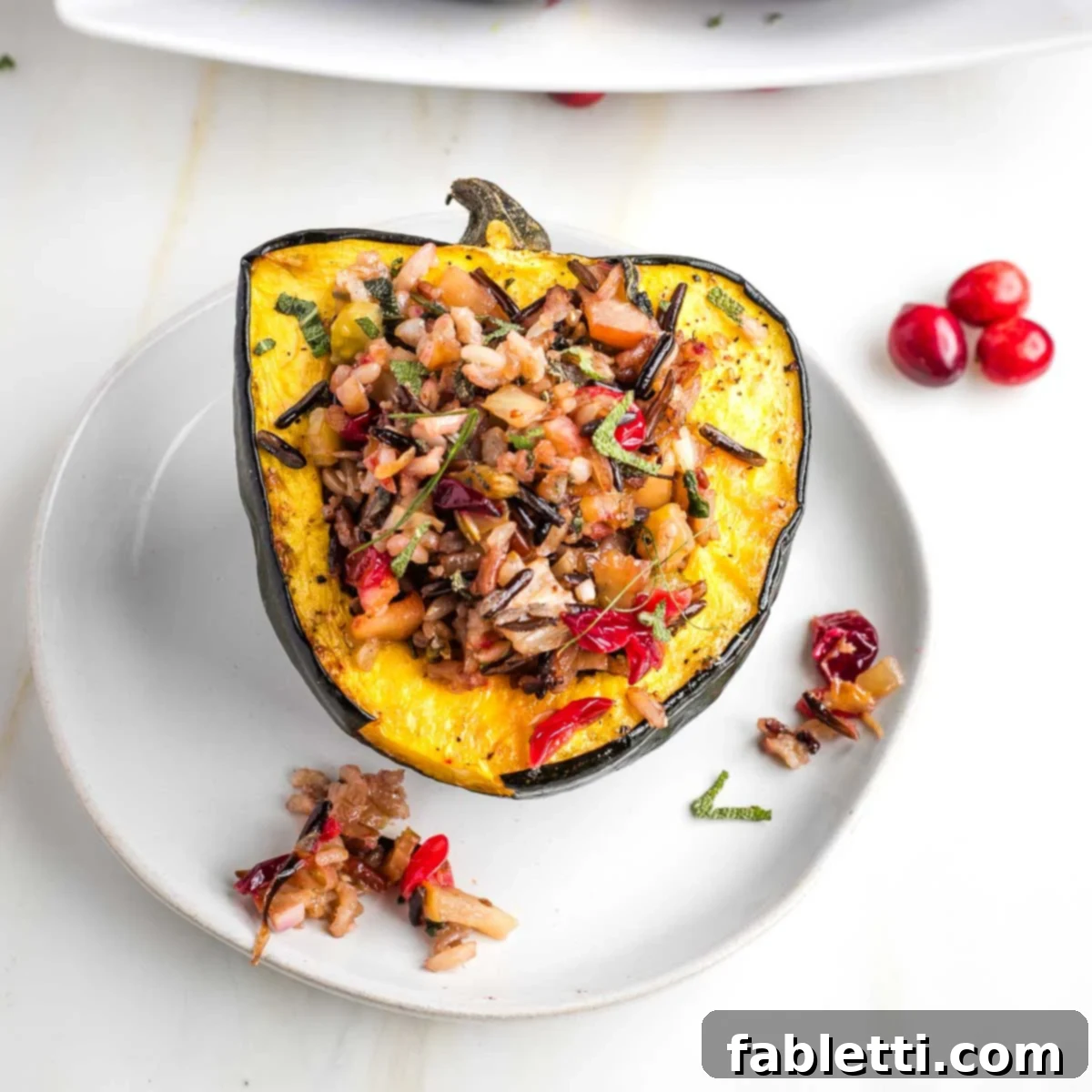Prepare to fall in love with this incredible Vegan Stuffed Acorn Squash with Wild Rice Stuffing. It’s truly the best plant-based acorn squash recipe you’ll ever make, offering a symphony of savory fall flavors that are both comforting and incredibly nourishing. Imagine perfectly roasted acorn squash halves, their naturally sweet flesh tender and inviting, brimming with a hearty, flavorful blend of wild rice, aromatic vegetables, crisp apples, and tart cranberries. This dish is elegant enough to grace your Thanksgiving table, yet surprisingly simple to prepare for a satisfying weeknight meal. Get ready to impress your guests and delight your taste buds with this wholesome, gluten-free, and utterly delicious creation.

Acorn squash holds a special place in my culinary heart. It’s wonderfully versatile, boasts an edible skin once cooked, and offers a natural sweetness that makes it a joy to incorporate into both sweet and savory dishes. Beyond its delightful taste, acorn squash is a nutritional powerhouse, generously packed with essential nutrients like fiber, potassium, vitamin C, and magnesium. This Vegan Stuffed Acorn Squash recipe transforms this humble vegetable into an extraordinarily delicious and satisfying main course that I frequently prepare. Its rich texture and robust flavors make it a perfect centerpiece for any meal. However, when time is short and I crave something quick and comforting, my go-to is often a simple yet delightful mashed acorn squash, proving just how adaptable this winter squash can be.
Why You’ll Adore This Vegan Stuffed Acorn Squash
This recipe isn’t just a meal; it’s an experience, especially for those seeking a vibrant and healthy addition to their fall and winter dining. Here’s why this Stuffed Acorn Squash with Wild Rice will become a beloved staple in your kitchen:
- The Ultimate Vegan Thanksgiving Meal or Effortless Fall Dinner: Whether you’re planning a grand holiday feast or simply seeking a wholesome and comforting meal after a long day, this recipe rises to the occasion. Its festive presentation and rich flavors make it a show-stopping centerpiece for any holiday table, while its straightforward preparation ensures it’s accessible enough for a casual weeknight.
- Deliciously Satisfying and Deeply Nourishing: Every bite offers a delightful blend of textures and tastes. The tender, sweet roasted squash perfectly complements the hearty, savory wild rice stuffing. It’s a meal that truly satisfies both hunger and soul, packed with fiber, vitamins, and plant-based protein to fuel your body.
- A Harmony of Flavors: The stuffing masterfully balances sweet and tart notes. Crisp, sweet apples provide a beautiful contrast to the bright, tangy cranberries. Meanwhile, the earthy aroma of sautéed fennel and onion, paired with the warm, herbaceous essence of sage, creates a complex, savory depth that is undeniably autumnal and incredibly inviting.
- Versatile Gluten-Free Stuffing: The wild rice stuffing itself is a culinary marvel. It’s naturally gluten-free and so flavorful that it can easily be served as a standalone side dish, perfect for those who want a lighter option or as an accompaniment to other festive entrees. Its vibrant colors and rich textures make it an attractive addition to any plate.
- A Hearty Plant-Based Main Dish for Autumn and Winter: For anyone embracing a plant-based lifestyle, or simply looking to incorporate more vegetables into their diet, this recipe is a dream come true. It’s substantial, filling, and packed with wholesome ingredients, making it an ideal choice for a healthy and satisfying main course during the colder months.
- Explore Other Stuffed Squash Options: If you’re a fan of diverse grain stuffings, or simply love stuffed squash, you might also enjoy my Stuffed Butternut Squash Recipe, which features a delightful quinoa stuffing. It offers a slightly different flavor profile while maintaining the comforting elegance of a stuffed winter squash.
How to Select the Perfect Acorn Squash for Stuffing
Selecting the right acorn squash is key to ensuring your stuffed dish is as delicious as possible. A well-chosen squash will be sweet, tender, and free from stringiness. Here’s a comprehensive guide to help you pick the best ones at the market:
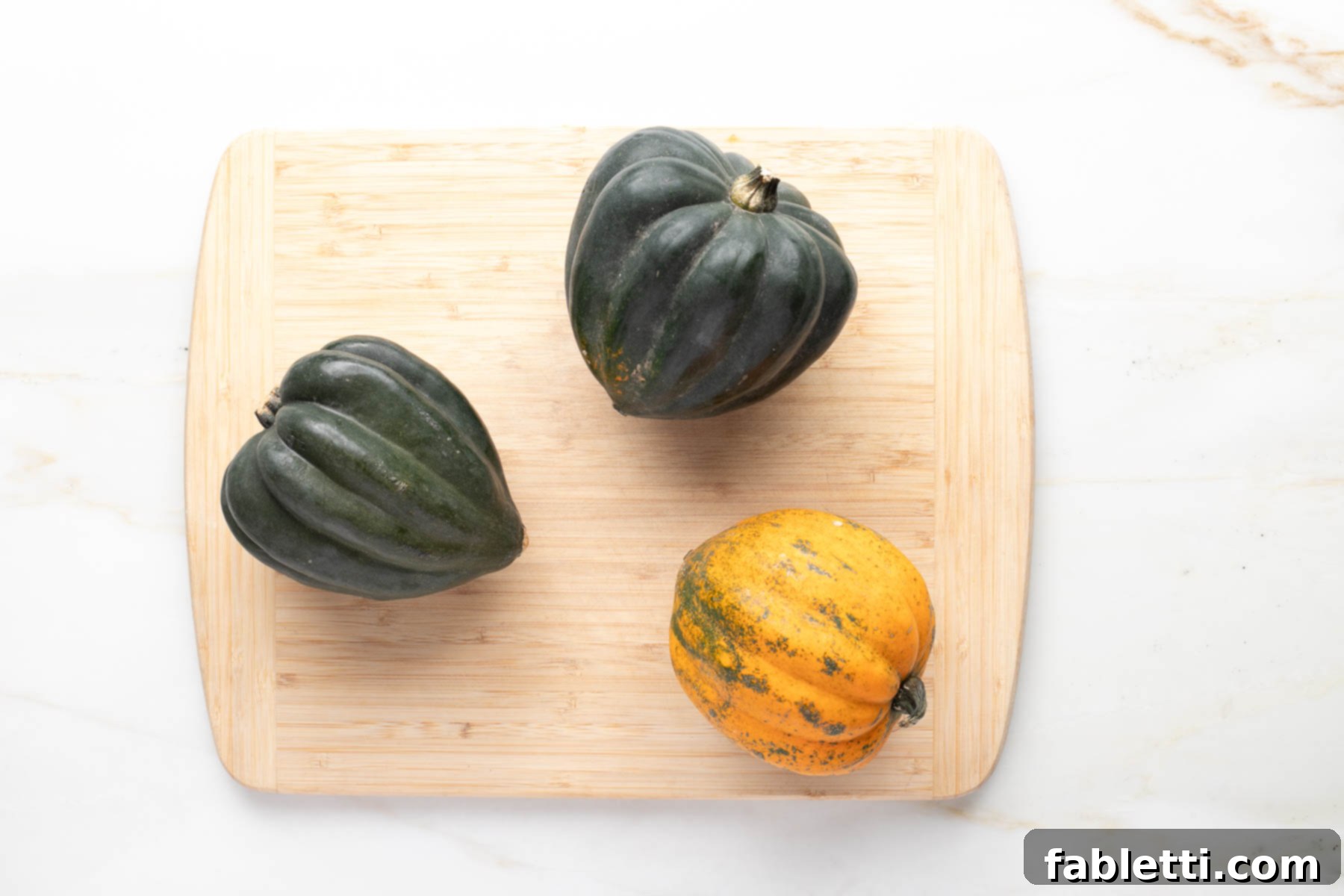
- Color Matters: Look for acorn squash with a deep, dark green rind. Patches of orange or yellow are acceptable and often indicate ripeness. However, if the squash is predominantly orange, it might be overripe, which can result in a drier, stringier texture and a less appealing flavor. The ideal squash strikes a balance between green and minimal orange.
- Examine the Skin: The skin should be firm, smooth, and dull in appearance. Avoid any squash that has soft spots, bruises, or significant blemishes, as these can be signs of spoilage or damage. A shiny skin, surprisingly, suggests that the squash was picked prematurely and might lack full flavor and sweetness.
- Feel the Weight: A good rule of thumb for any produce is to choose one that feels heavy for its size. This indicates a dense flesh that retains plenty of moisture, leading to a tender and succulent cooked squash. Lightweight squash, on the other hand, often implies a loss of moisture, resulting in a dry and less palatable end product.
- Proper Storage: Once you’ve brought your perfect acorn squash home, store it in a cool, dry place away from direct sunlight. A pantry, cellar, or even a cool countertop will suffice. Avoid refrigerating uncooked whole squash, as this can actually shorten its shelf life. Stored correctly, acorn squash can last for several weeks, if not months, allowing you to enjoy this delightful vegetable whenever the craving strikes.
Key Ingredients & Smart Substitutions for Your Stuffing
This Vegan Stuffed Acorn Squash recipe is built on a foundation of fresh, wholesome ingredients that come together to create a truly spectacular flavor profile. While we love the specific combination outlined, we also understand the need for flexibility in the kitchen. Here’s a detailed look at the core components and some clever substitutions you can make:

- Acorn Squash: The star of our dish! Its unique shape and naturally sweet, nutty flavor are perfect for stuffing. If acorn squash isn’t available, or you simply want to try something different, feel free to substitute with other winter squash varieties. Kabocha squash, butternut squash, and buttercup squash are all excellent options, offering similar textures and flavors that will hold up beautifully to the hearty stuffing.
- Wild Rice: This grain brings a wonderful chewy texture and earthy flavor to the stuffing, making it incredibly satisfying. If wild rice is hard to find, or you prefer another grain, a combination of black rice and white rice can mimic its appearance and some of its texture. Other whole grains that would work exceptionally well include quinoa (for a protein boost), farro, brown rice, or barley, each lending its own unique character to the dish.
- Yellow Onion: Provides a foundational sweetness and aromatic depth when sautéed. For a slightly different flavor, you can substitute yellow onion with leeks (for a milder, more delicate onion flavor), red onion (which adds a touch of color and a sharper bite), white onion, green onion, or a sweet Vidalia onion.
- Celery: Adds a crucial crisp texture and a fresh, subtle bitterness that balances the other ingredients. There isn’t a direct substitute that captures its unique crunch and flavor quite as well, so it’s highly recommended to include it.
- Fennel: Don’t let the thought of raw fennel’s licorice flavor deter you! When sautéed, fennel undergoes a magical transformation. It caramelizes, becoming incredibly sweet and tender, and its strong licorice notes completely dissipate, leaving behind a delicate, anise-like aroma that beautifully complements the other fall flavors.
- Fresh Apples: Any type of apple will work wonderfully in this stuffing, from crisp Honeycrisp to sweet Fuji or tart Granny Smith. They add a burst of juicy sweetness and a slight tang, enhancing the autumnal profile. Pears can also be used as an excellent alternative, offering a similar sweetness and softer texture.
- Cranberries: Fresh cranberries are a game-changer in this recipe, introducing a deliciously tart and tangy counterpoint that brightens the entire dish. If fresh cranberries are out of season, you can easily substitute dried cranberries. Look for unsweetened varieties to control the sugar content. If using dried, stir them in at the very end as they don’t require cooking and will soften from the residual heat.
- Garlic: The recipe calls for 4 cloves, but as any garlic lover knows, you can always add more if you like! Minced garlic provides an indispensable savory pungency that elevates all the other flavors in the stuffing.
- Fresh Sage: Sage is the quintessential herb for fall dishes, lending a warm, earthy, and slightly peppery flavor that pairs perfectly with squash and cranberries. You can substitute with other fresh herbs like rosemary, thyme, or oregano for a different aromatic profile. Fresh parsley also works for a lighter, brighter note. If fresh herbs aren’t available, use ⅓ of the quantity of dried herbs, as their flavor is more concentrated.
- Optional Sautéing Liquid: For sautéing the vegetables, you have several healthy and flavorful options. You can use a tablespoon or two of extra virgin olive oil for richness, or opt for a no-oil approach by using vegetable broth, white wine for added depth, or even plain water. A combination of these liquids can also be used to achieve your desired flavor and cooking method.
By understanding these ingredients and their potential substitutions, you can confidently customize this recipe to suit your preferences and what you have on hand, ensuring a delicious and adaptable meal every time.
Step-by-Step Guide to Creating Your Stuffed Acorn Squash
Step 1: Perfectly Roast the Acorn Squash
Achieving a tender, sweet, and slightly caramelized acorn squash base is crucial for this recipe. Here’s how to roast it to perfection:
Begin by preheating your oven to a robust 400 degrees Fahrenheit (200 degrees Celsius). Prepare a large rimmed baking sheet by lining it with unbleached parchment paper. Alternatively, you can use a 9×13 inch baking pan.
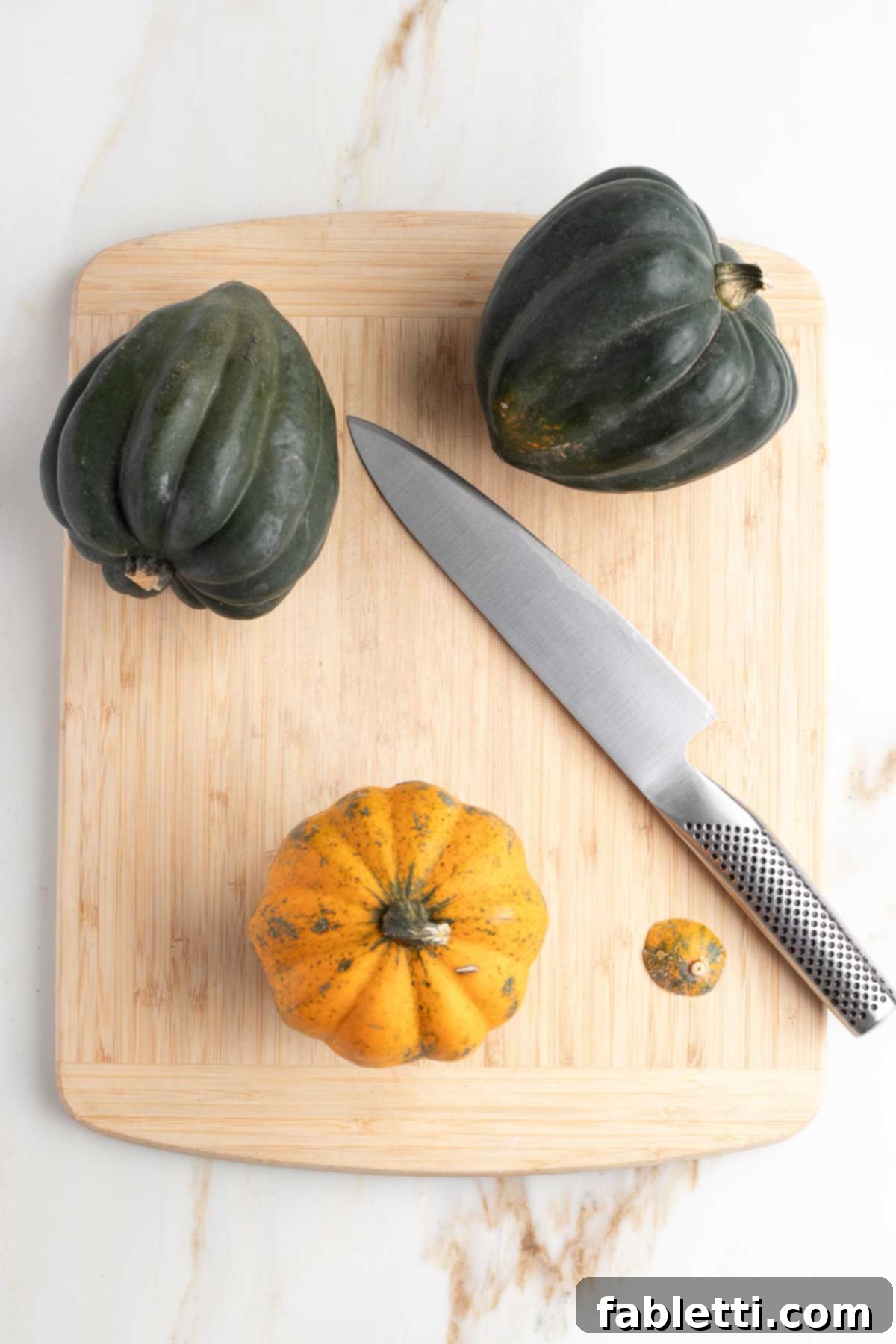
With a sharp chef’s knife, carefully cut a small sliver off the bottom of each acorn squash. This seemingly minor step is crucial as it creates a stable base, allowing the squash to stand upright on your cutting board without wobbling, making the halving process much safer and easier.
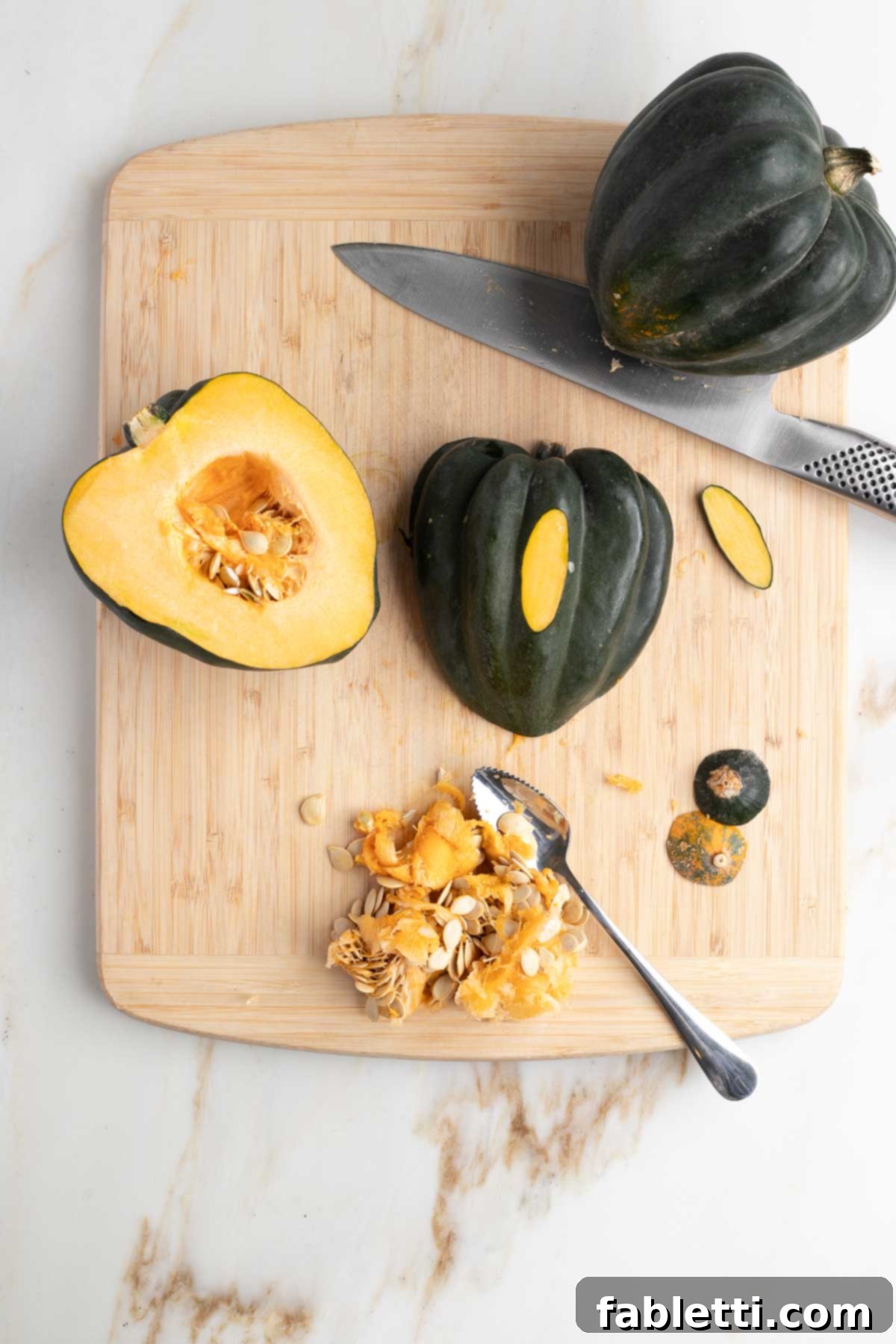
Now, carefully cut through the top of each squash, dividing it into two equal halves. Using a sturdy spoon, preferably a grapefruit spoon due to its serrated edge, scoop out all the seeds and fibrous strings from the center of each squash half. Discard these or set the seeds aside if you plan to roast them for a crunchy garnish!

Place the prepared squash halves flat, cut-side up, in your chosen baking dish or on the parchment-lined baking sheet. Drizzle a small amount of olive oil over the exposed flesh of each squash half. This helps with caramelization and adds a lovely flavor. Season generously with a sprinkle of sea salt and freshly ground black pepper.
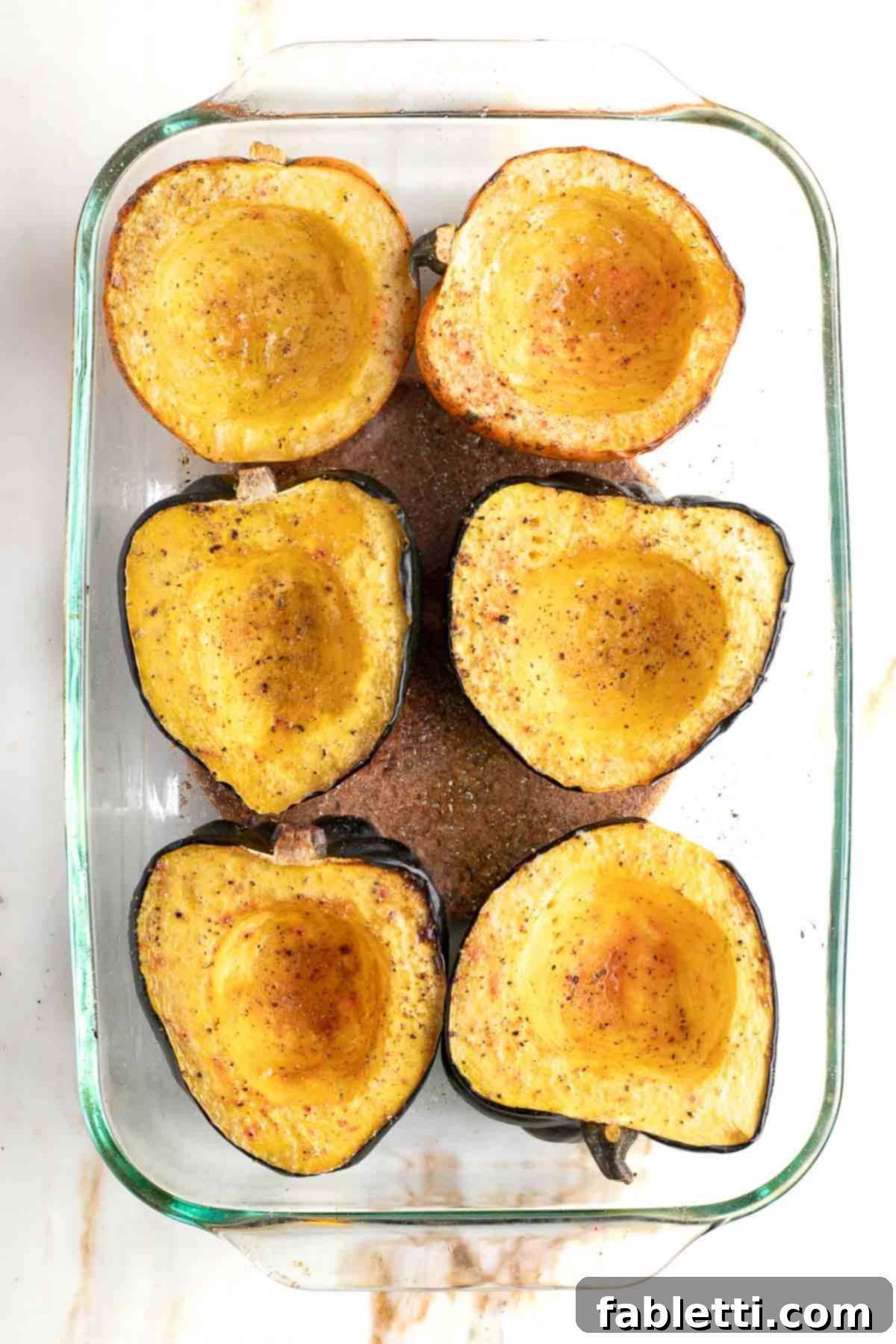
Bake the squash in the preheated 400-degree Fahrenheit oven for approximately 40 minutes. The exact cooking time may vary slightly depending on the size and thickness of your squash halves, so look for visual cues. They are ready when the flesh is fork-tender, easily pierced with a fork, and the edges begin to show a slight golden-brown caramelization. Remove from the oven and set aside while you prepare the stuffing.
Step 2: Prepare the Flavorful Wild Rice
Wild rice is the hearty backbone of our stuffing. Cooking it correctly ensures a delightful, chewy texture that perfectly complements the other ingredients.

While your acorn squash is roasting, turn your attention to the wild rice. Place the dry wild rice in a fine-mesh sieve and rinse it thoroughly under cool running water. Continue rinsing until the water runs completely clear. This step helps remove any excess starch and ensures a clean, distinct flavor in your cooked rice.

In a small saucepan, bring 2 cups of vegetable stock or water to a rolling boil over medium-high heat. Once boiling, stir in the rinsed wild rice. Immediately reduce the heat to low, cover the saucepan tightly, and let it simmer for approximately 25 minutes. Always refer to your wild rice package instructions, as cooking times can sometimes vary. After 25 minutes, remove the saucepan from the heat, but keep it covered for an additional 10 minutes. This allows the rice to finish steaming perfectly, resulting in distinct, fluffy grains.
Step 3: Expertly Prep Your Stuffing Vegetables
Efficient and proper vegetable preparation is key to a smooth cooking process and a beautifully textured stuffing.
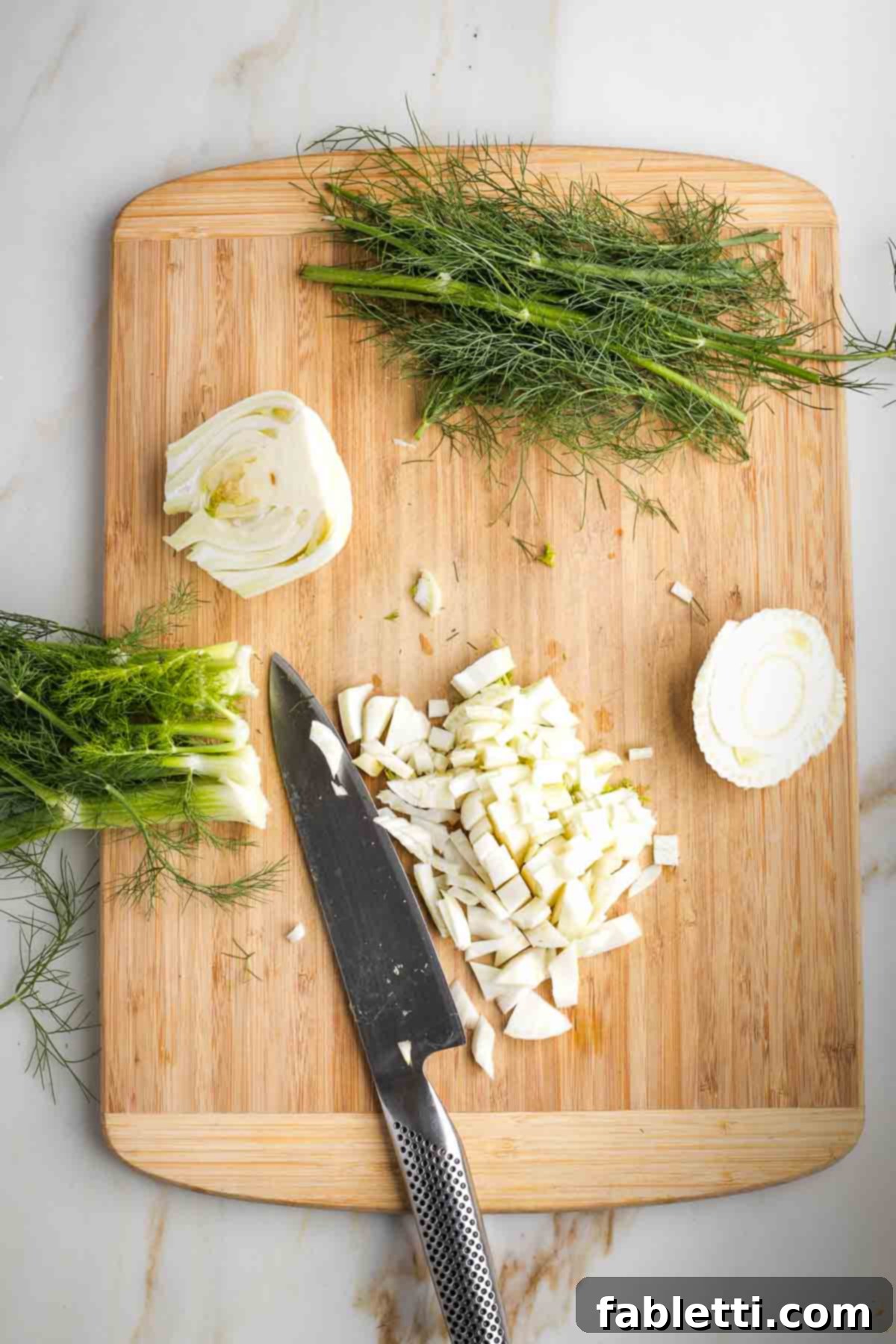
To dice the fennel: first, slice off the tough, woody bottom and trim away the green fronds from the top (you can save these delicate fronds for garnish later!). Cut the bulb through its center. Place one half cut-side down on your cutting board and make thin slices across it, then cut across the other way to create small, uniform dice. Repeat with the remaining half. Uniform dicing ensures even cooking.
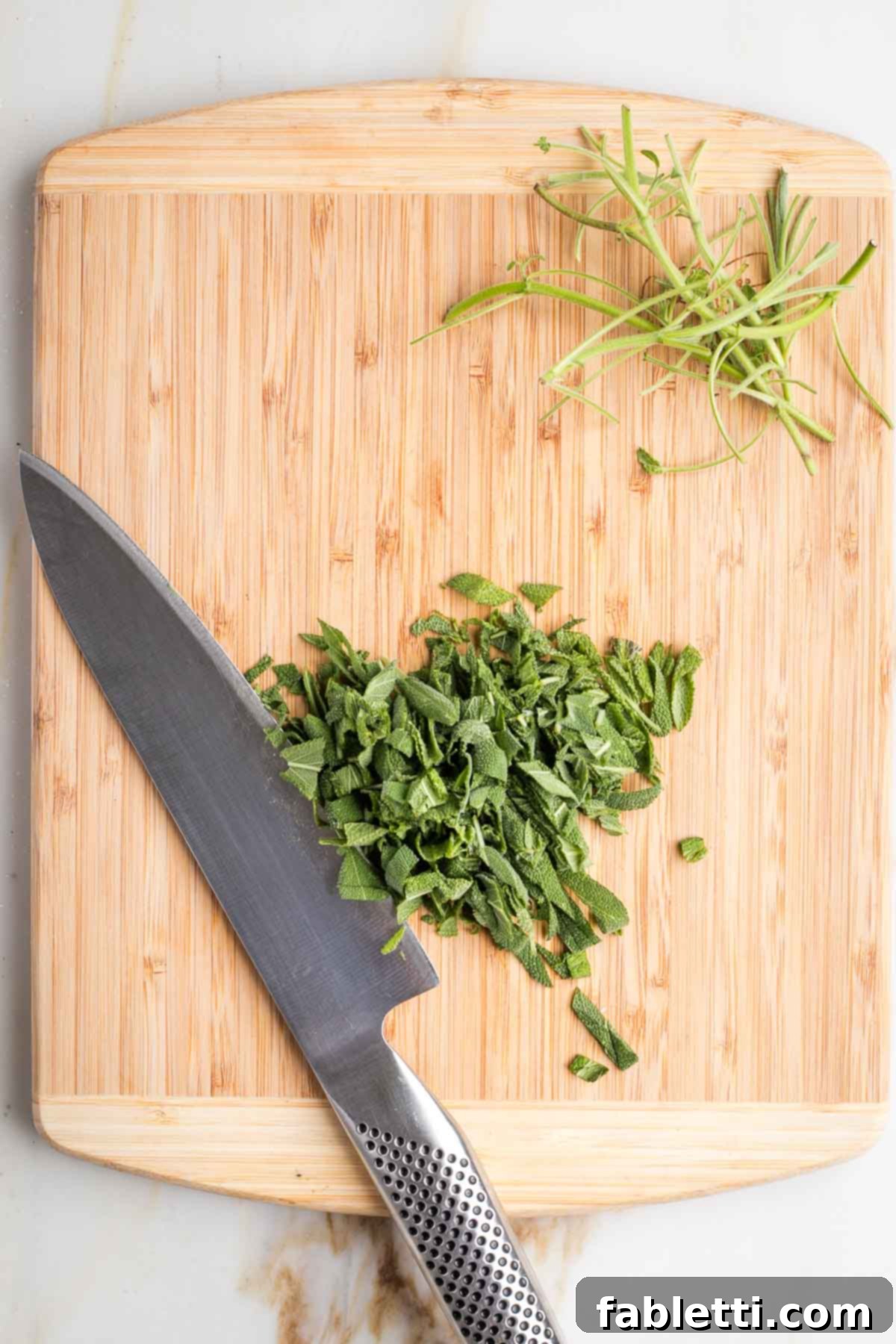
Stack your fresh sage leaves neatly and roughly chop them. Proceed to dice the yellow onion, celery stalks, and fresh apples into small, consistent pieces. Mince the garlic cloves finely. Finally, rinse the fresh cranberries under cool water and carefully pick through them, discarding any soft, damaged berries or small stems. Having all your ingredients prepped and ready (mise en place) will make the stuffing assembly a breeze.
Step 4: Assemble the Rich and Flavorful Stuffing
This is where the magic happens – combining all the fresh ingredients to create a truly irresistible stuffing.
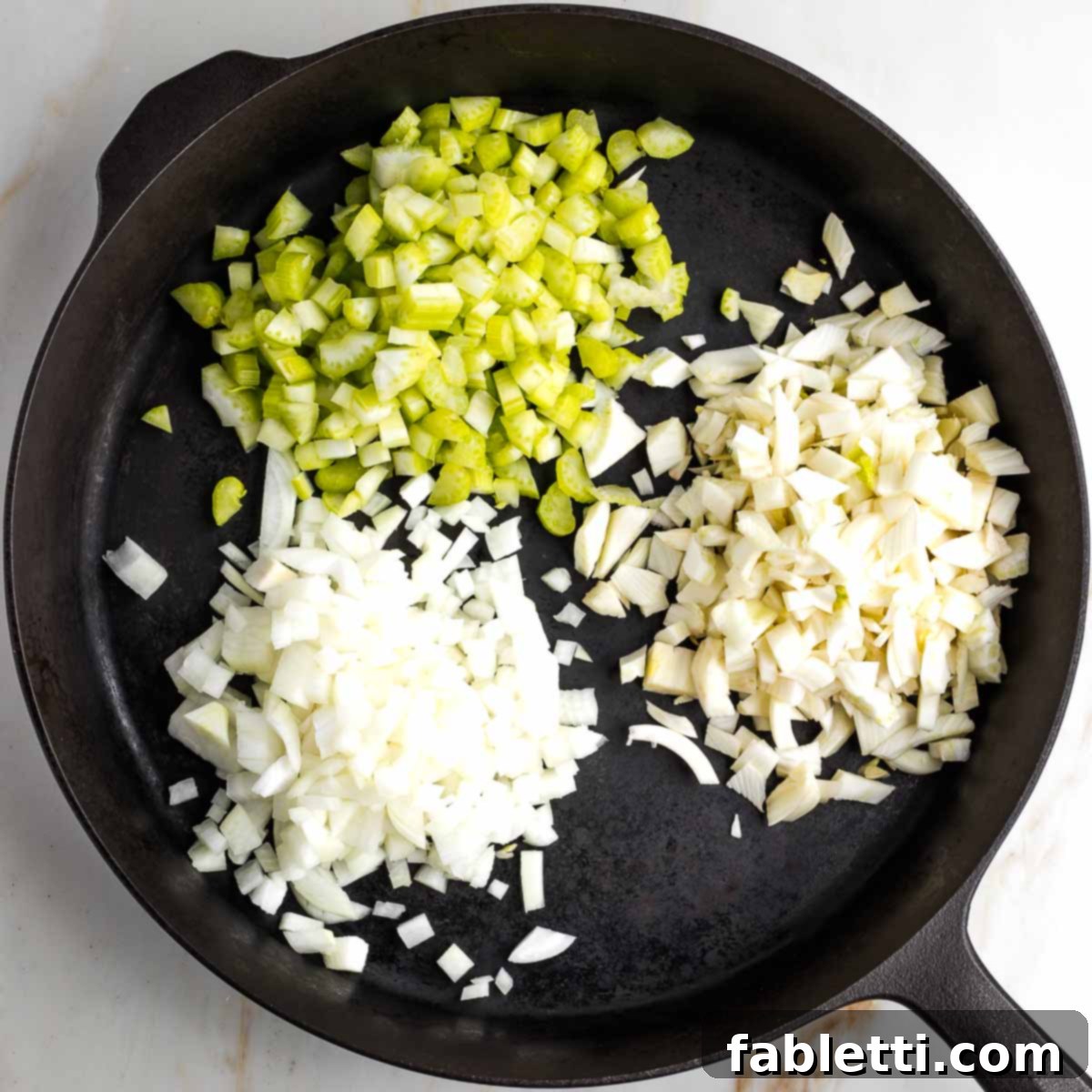
Heat a large skillet, preferably a heavy-bottomed one like cast iron, over medium heat. Add a tablespoon of extra virgin olive oil to the pan, or for a lighter approach, use a splash of vegetable broth. Add the chopped onion, celery, and fennel to the skillet. Sauté these aromatic vegetables, stirring occasionally, allowing them to soften and begin to release their natural sugars.

As the vegetables cook, sprinkle them with a half teaspoon each of sea salt and ground black pepper. Continue to sauté, stirring periodically, until the vegetables are tender and begin to turn a beautiful golden brown. This caramelization process is essential for developing deep, complex flavors in your stuffing, particularly for the fennel which loses its licorice bite and becomes wonderfully sweet.

Once the vegetables are perfectly browned, add the fresh cranberries, diced apples, and minced garlic to the skillet. Pour in ¼ cup of liquid – this can be vegetable broth, water, white wine, or a combination. The liquid helps to deglaze the pan, pick up all those delicious browned bits, and allows the fruit to gently cook and soften without drying out.
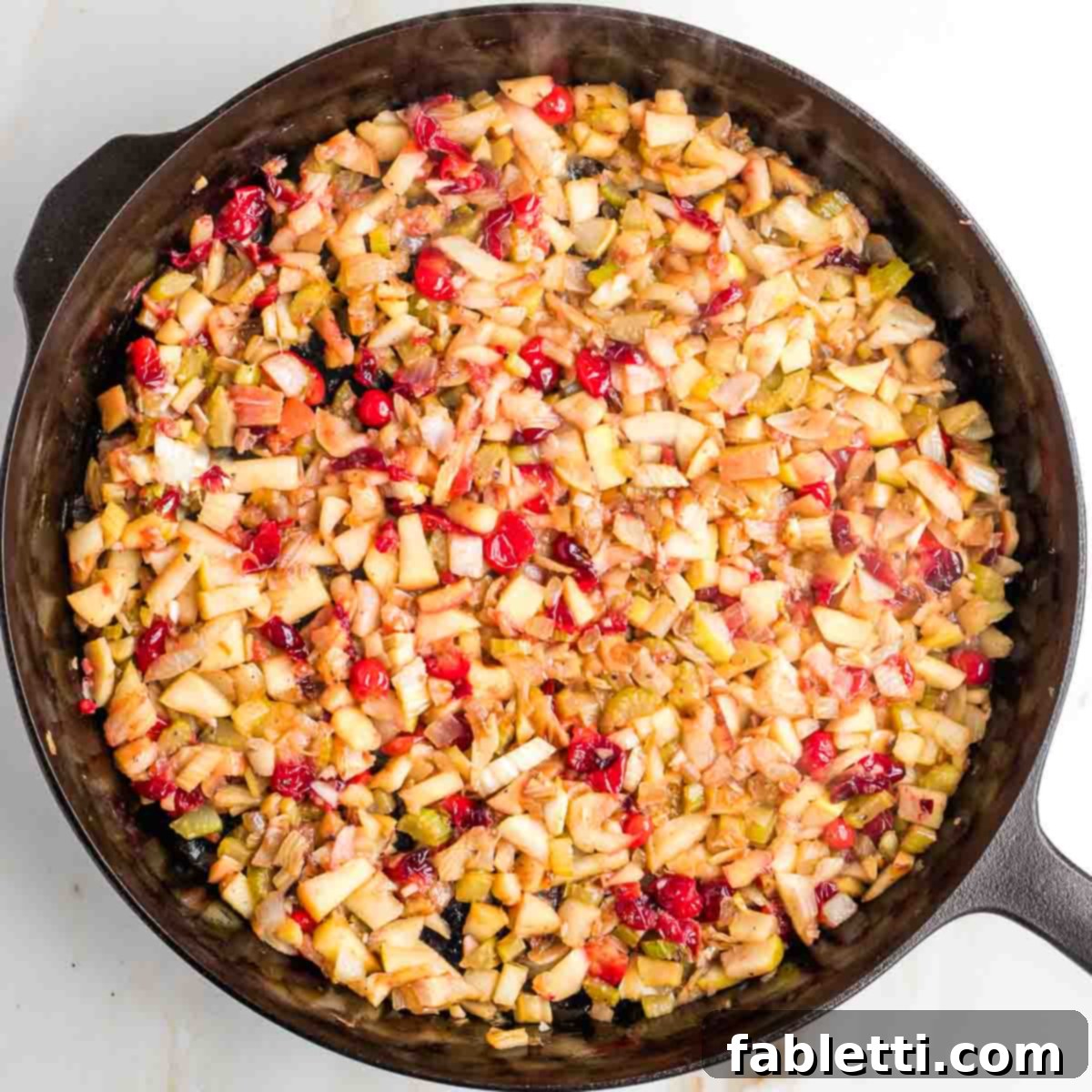
Continue to cook the mixture for about 5 to 8 minutes, stirring occasionally. During this time, the cranberries will soften and some will begin to “pop,” releasing their vibrant tart juices. For a more intense cranberry flavor and softer texture, use the back of your spoon or spatula to gently mash any cranberries that haven’t burst open on their own.

Once the cranberries and apples have softened to your liking, turn off the heat. Stir in the freshly chopped sage. The residual heat from the skillet will gently warm the sage, allowing its aromatic oils to release without overcooking it, preserving its fresh, vibrant flavor.
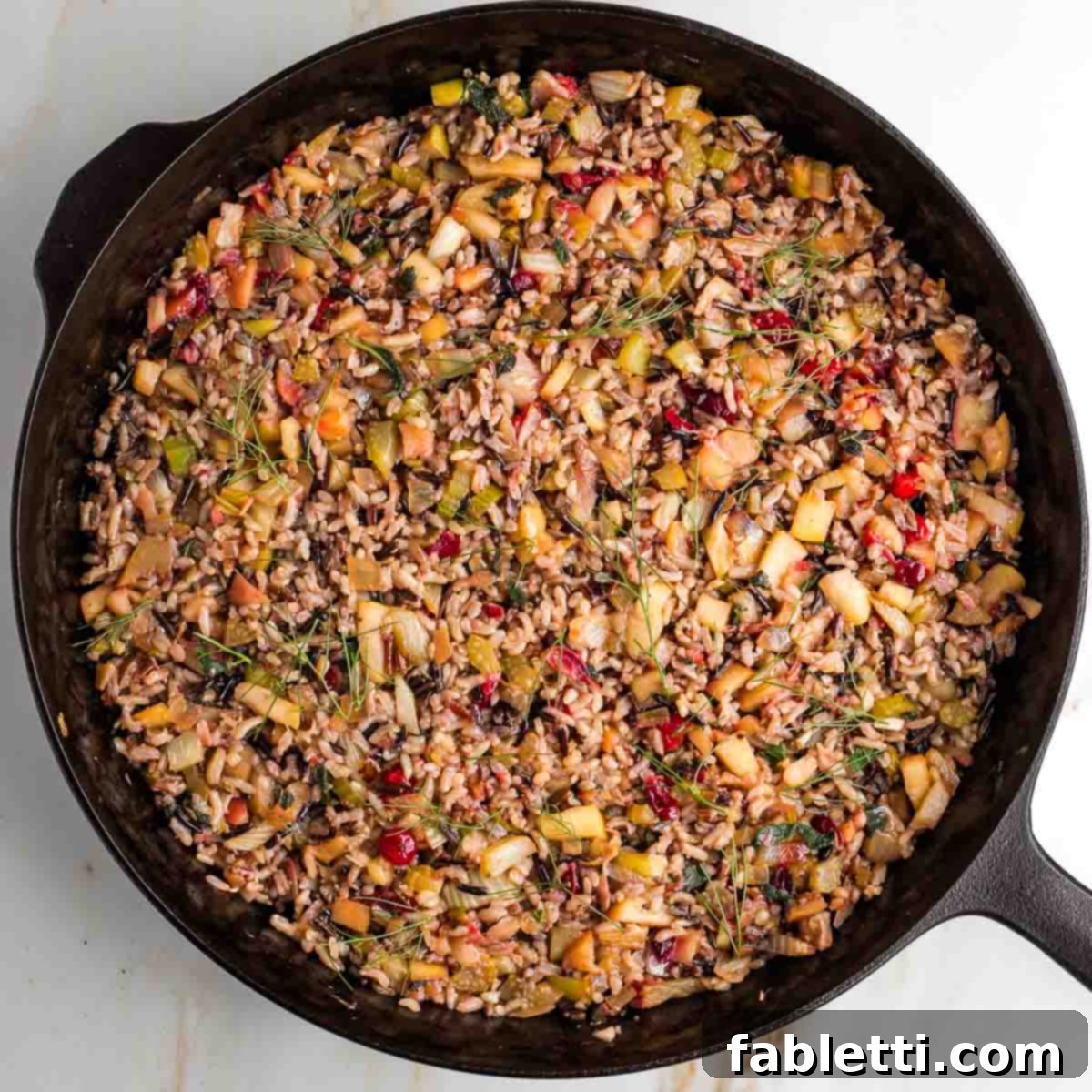
Fluff the cooked wild rice with a fork, then add it to the skillet with the sautéed vegetable and fruit mixture. Mix everything thoroughly until all ingredients are well incorporated, ensuring an even distribution of flavors and textures throughout the stuffing. At this point, the stuffing is complete and incredibly delicious on its own! If you’re preparing ahead, you can store this stuffing in an airtight container in the refrigerator for up to 5 days before proceeding to stuff the squash.
Step 5: Stuff and Finish Your Acorn Squash
The grand finale! Bringing together the tender roasted squash and the aromatic wild rice stuffing.
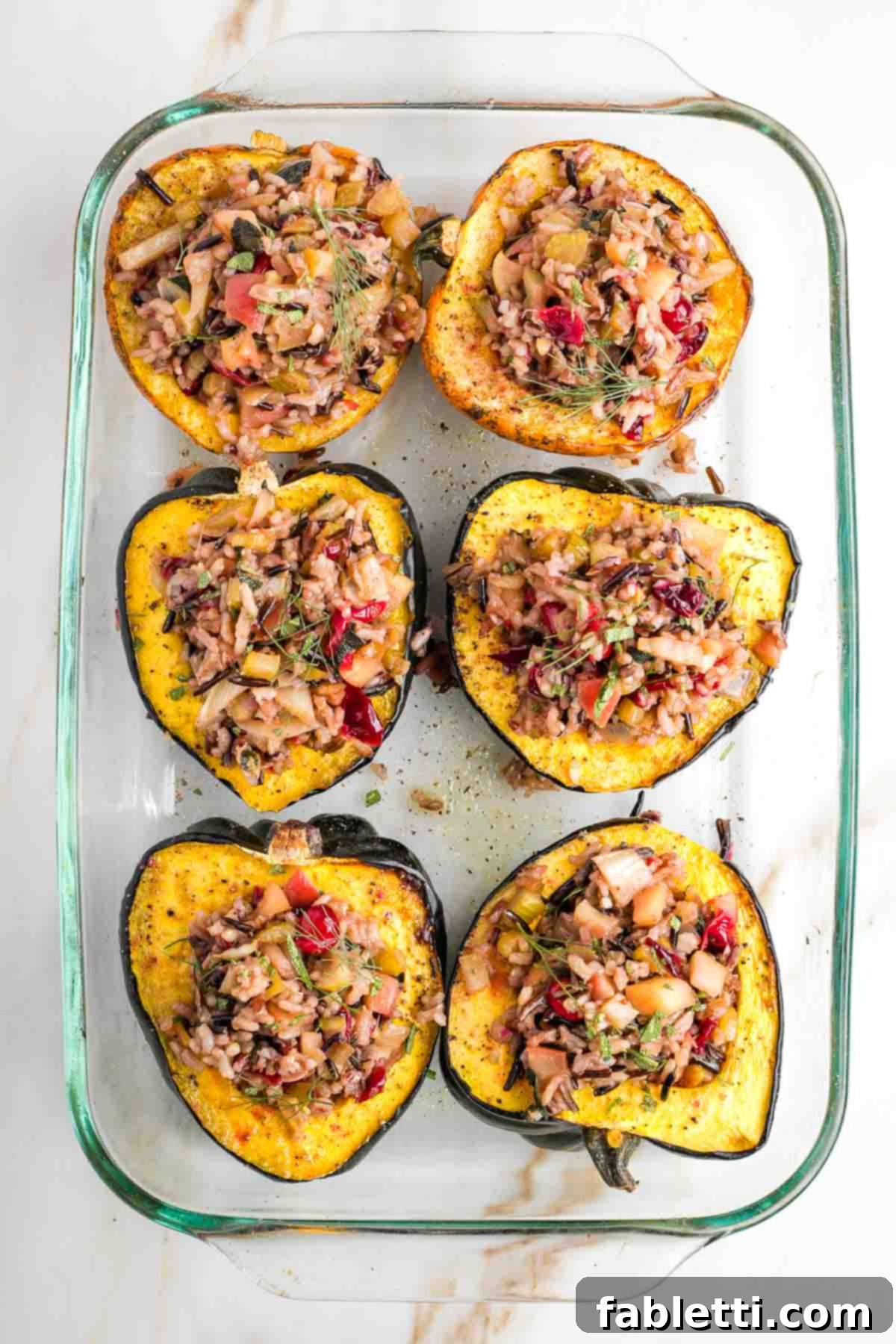
Once your roasted acorn squash halves are fork-tender and slightly cooled, generously scoop the wild rice stuffing mixture into each hollowed-out squash cavity. Fill them high, creating a beautiful, overflowing presentation. If you plan to serve the dish immediately and prefer a crispy topping for your stuffing, place the stuffed squash back into the oven at a slightly higher temperature of 425 degrees Fahrenheit (220 degrees Celsius) for about 15 minutes. This quick final bake will heat the stuffing through and give it a delightful, slightly browned crust. Alternatively, if you are preparing this dish in advance, tightly cover the stuffed squash with aluminum foil and refrigerate it. It will be ready to heat and serve later at your convenience.
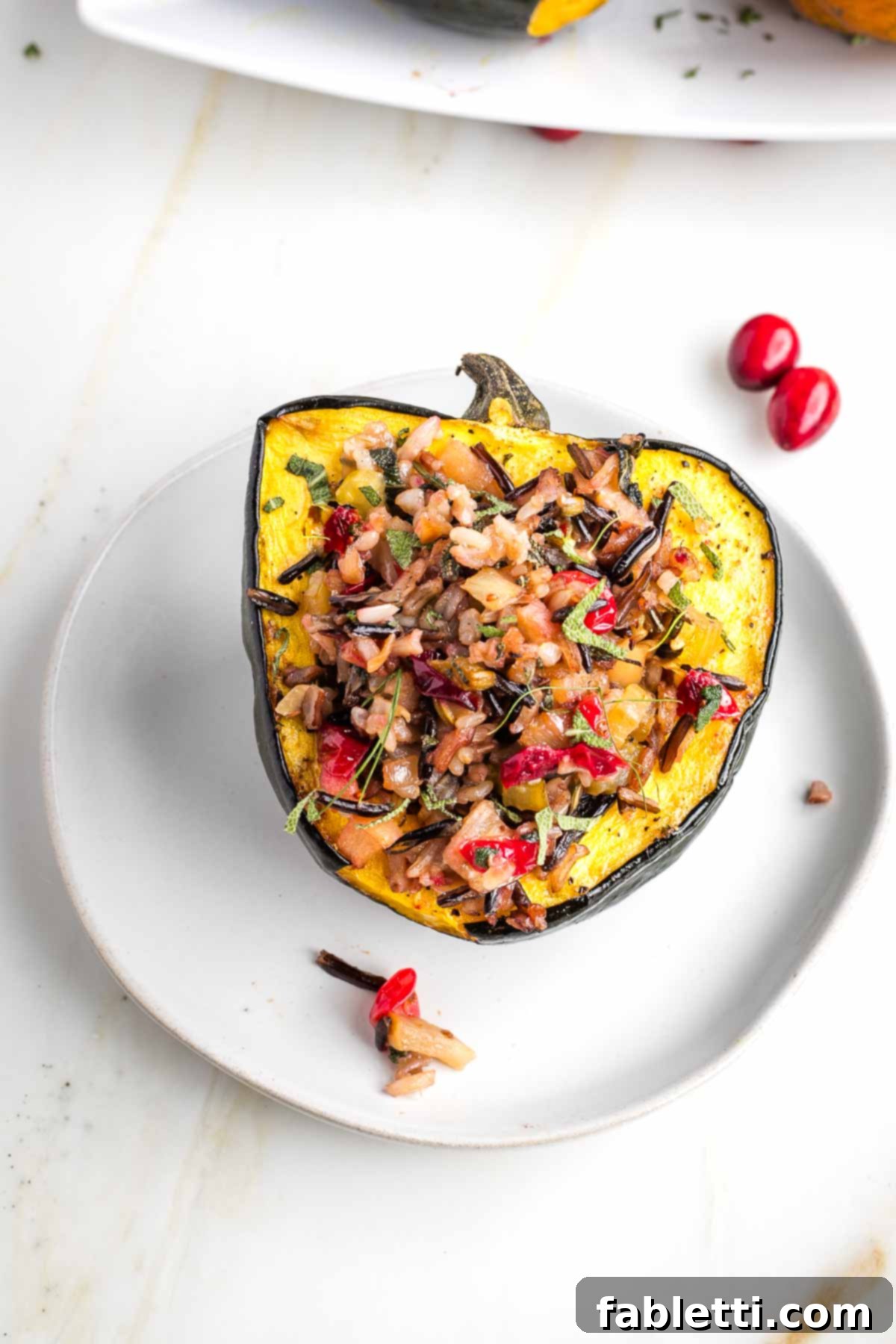
Serving, Storage, and Reheating Tips for Convenience
To ensure you get the most out of your delicious Vegan Stuffed Acorn Squash, here are some practical tips for serving, storing, and reheating:
- Serving Suggestions: This versatile dish can be served warm, straight from the oven, or at room temperature for a lighter option. Vegan Stuffed Acorn Squash makes a complete and satisfying main course on its own, perfect for a plant-based meal. It also shines as an exquisite side dish, adding color, flavor, and texture to any holiday table or special occasion. Garnish with a few fresh sage leaves or the delicate fennel fronds for an elegant touch.
- Storage Guidelines: The prepared wild rice stuffing will stay fresh and flavorful when stored in an airtight container in the refrigerator for up to 5 days. Once stuffed, the squash halves should also be covered tightly with aluminum foil or placed in an airtight container and refrigerated for up to 5 days. While it’s tempting to freeze leftovers, the texture of cooked squash tends to become mushy and watery after freezing and thawing, so it’s generally not recommended for this recipe to maintain optimal quality.
- Reheating Instructions: To reheat stuffed acorn squash, preheat your oven to 425 degrees Fahrenheit (220 degrees Celsius). Place the stuffed squash halves in a baking dish, cover loosely with foil (especially if you don’t want the topping to crisp further), and bake for approximately 20 minutes, or until thoroughly heated through to the center. For a quick reheat, individual portions can be gently warmed in the microwave, though the oven method offers superior texture.
Debra’s Pro Tips for Stuffed Acorn Squash Perfection
Elevate your Vegan Stuffed Acorn Squash from great to extraordinary with these expert tips:

- Don’t Discard Those Seeds: Just like pumpkin seeds, acorn squash seeds are delicious when roasted! After scooping them out, clean them, toss with a little oil and salt, and roast them alongside your squash (or separately). Once cooled, stir these crunchy, nutty seeds into your finished stuffing for an extra layer of texture and flavor, or use them as a delightful garnish.
- Adjusting Cranberry Tartness: Fresh cranberries offer a wonderful, vibrant tartness that cuts through the richness of the dish. However, if you prefer a slightly less tangy profile, simply mix a tablespoon or two of maple syrup or agave nectar into the finished wild rice stuffing. Taste and adjust to your preference for a perfectly balanced sweetness.
- A Standalone Thanksgiving Side: This wild rice stuffing is so flavorful and robust that it truly shines on its own. Consider making a larger batch and serving it in a beautiful large bowl as a healthy, vibrant, and incredibly delicious Thanksgiving side dish, even if you’re not stuffing squash. It’s an excellent gluten-free and vegan alternative to traditional bread stuffings.
More Irresistible Vegan Thanksgiving Recipes to Try
Planning a full plant-based holiday feast? Complement your Stuffed Acorn Squash with these other fantastic vegan Thanksgiving recipes:
- Easy Vegan Gravy Recipe
- Gluten-free Cornbread Stuffing
- Easy Recipe for Green Beans with Almonds
- Butternut and Beetroot Salad
Did you enjoy making this recipe? We love hearing from you! Commenting and rating recipes is one of the best ways to support your favorite food bloggers. If you tried this delicious Vegan Stuffed Acorn Squash, please consider leaving a five-star rating and a comment below to share your experience. We also invite you to share your beautiful photos on Instagram by tagging me @dkhealthcoach and using the hashtag #debraklein. Your feedback and shares truly help our community grow!
📖 Recipe Card

Vegan Stuffed Acorn Squash
Debra Klein
Rate this Recipe
Pin Recipe
10 minutes
45 minutes
55 minutes
Main Course, Side Dish
American
6
278
kcal
Ingredients
Squash
-
3 small acorn squash halved -
1 tablespoon extra virgin olive oil -
¼ teaspoon sea salt -
¼ tsp ground black pepper
Wild Rice Stuffing
-
1 cup dry wild rice -
2 ½ cups
vegetable broth
divided -
l large yellow onion diced -
2 stalks celery diced -
1 bulb fennel diced -
½ teaspoon sea salt -
½ teaspoon ground black pepper -
2 large apples diced -
1 cup fresh cranberries -
4 cloves garlic minced -
2 tblsp chopped fresh sage sub with 2 teaspoon dried sage
Instructions
- Preheat oven to 400°F (200°C). Use a 9×13 inch casserole dish, or line a baking tray with unbleached parchment paper.
Roast the Squash: Wash the outside of the squash thoroughly before beginning. Cut a small sliver off the bottom of each squash, just enough so it sits flat and stable on a cutting board. Halve the squash through the stem and scoop out and discard the seeds and strings (or save seeds for roasting). Place the halves in the prepared pan, drizzle with olive oil, and sprinkle with salt and pepper. Bake for 40-45 minutes, or until the flesh is fork-tender.
Rice: Rinse the wild rice well in a fine mesh sieve under cool water until the water runs clear. In a small saucepan, bring 2 cups of vegetable broth to a boil. Stir in the rinsed rice, then reduce the heat to medium-low. Simmer covered for 25 minutes. Turn off the heat and leave covered for an additional 10 minutes to finish steaming and fluff.
Prep the Veggies: Dice the onion, celery, fennel (removing woody ends and fronds), and apple into uniform pieces. Mince the garlic cloves finely. Rinse the fresh cranberries and pick through, discarding any stems or damaged berries. Stack the sage leaves and roughly chop.
Make the Stuffing: While the rice and squash are cooking, prepare the filling. In a heavy skillet over medium heat, sauté the diced onion, celery, and fennel with a tablespoon of olive oil or vegetable broth for 5 minutes, until softened. Stir in the cranberries, diced apples, and minced garlic along with ¼ cup of the vegetable broth. Cook for another 5-8 minutes, stirring occasionally, as the cranberries soften and pop. Use the back of your spoon or spatula to mash a few of the cranberries for extra burst of flavor. Turn off the heat. Mix in the chopped sage. Fluff the cooked wild rice with a fork and then stir it into the veggie mixture until well incorporated.
- The squash is finished when fork-tender. Generously fill each cooked squash half with large scoops of the savory wild rice stuffing. Sprinkle with additional fresh sage or use the fennel fronds to garnish for an attractive presentation. If you desire a crisper topping for the stuffing, return the stuffed squash to the oven at 425°F (220°C) for 15 minutes before serving.
Meal Prep: For convenience, you can cook the wild rice up to 3 days in advance and prepare the stuffing mixture up to 3 days in advance. Once the squash is roasted and stuffed, you can refrigerate it in a baking dish, tightly covered with foil, until you’re ready to use it. Reheat in a 375°F (190°C) oven for about 20 minutes, or until heated through.
Notes
For no-oil acorn squash: If you prefer to skip the oil, simply sprinkle the squash halves with salt and pepper and turn them cut-side down to roast in the oven. This method helps them retain moisture and prevents them from drying out. Continue with the rest of the recipe as directed.
If your squash halves don’t sit flat and stable in the baking dish, carefully cut a super thin sliver off the ridged bottom. This will create a flat surface, ensuring they sit without wobbling, which is important for even roasting and stability when stuffing.
Nutrition
Calories:
278
kcal
Carbohydrates:
58
g
Protein:
7
g
Fat:
4
g
Saturated Fat:
1
g
Polyunsaturated Fat:
1
g
Monounsaturated Fat:
2
g
Sodium:
331
mg
Potassium:
1163
mg
Fiber:
9
g
Sugar:
11
g
Vitamin A:
960
IU
Vitamin C:
35
mg
Calcium:
121
mg
Iron:
3
mg
Note
The nutrition calculations were done using online tools. To obtain the most accurate representation of the nutritional information in any given recipe, you should calculate the nutritional information with the actual ingredients you used. You are ultimately responsible for ensuring that any nutritional information is accurate, complete and useful.
Did you make this recipe?
Please leave a review below, then snap a picture and tag me @dkhealthcoach or use hashtag #dkhealtcoach on Instagram so I can see it!!
